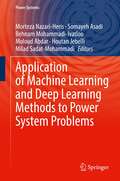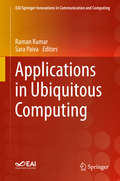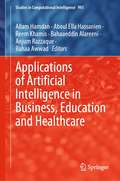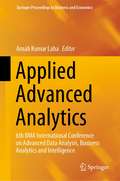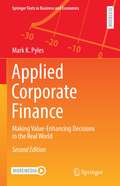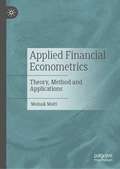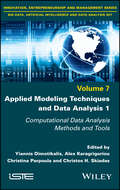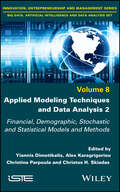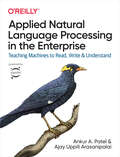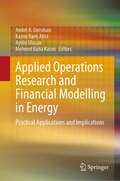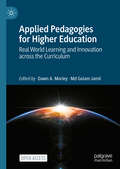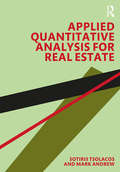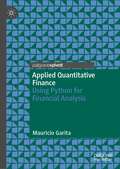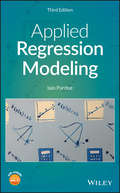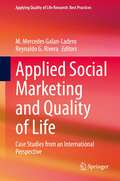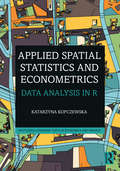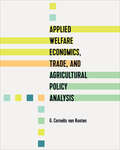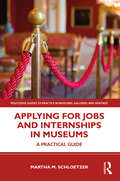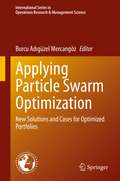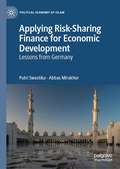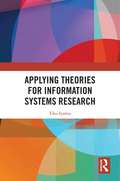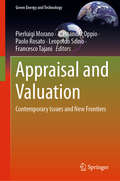- Table View
- List View
Application of Machine Learning and Deep Learning Methods to Power System Problems (Power Systems)
by Behnam Mohammadi-Ivatloo Morteza Nazari-Heris Somayeh Asadi Moloud Abdar Houtan Jebelli Milad Sadat-MohammadiThis book evaluates the role of innovative machine learning and deep learning methods in dealing with power system issues, concentrating on recent developments and advances that improve planning, operation, and control of power systems. Cutting-edge case studies from around the world consider prediction, classification, clustering, and fault/event detection in power systems, providing effective and promising solutions for many novel challenges faced by power system operators. Written by leading experts, the book will be an ideal resource for researchers and engineers working in the electrical power engineering and power system planning communities, as well as students in advanced graduate-level courses.
Applications in Ubiquitous Computing (EAI/Springer Innovations in Communication and Computing)
by Raman Kumar Sara PaivaThis book takes a deep dive into ubiquitous computing for applications in health, business, education, tourism, and transportation. The rich interdisciplinary contents of the book appeal to readers from diverse disciplines who aspire to create new and innovative research initiatives and applications in ubiquitous computing. Topics include condition monitoring and diagnostics; multi-objective optimization in design, multi-objective optimization of machining parameters, and more. The book benefits researchers, advanced students, as well as practitioners interested in applications of ubiquitous computing. Features practical, tested applications in ubiquitous computingIncludes applications such as health, business, education, electronics, tourism, and transportationApplicable to researchers, academics, students, and professionals
Applications of Artificial Intelligence in Business, Education and Healthcare (Studies in Computational Intelligence #954)
by Aboul Ella Hassanien Allam Hamdan Anjum Razzaque Bahaaeddin Alareeni Reem Khamis Bahaa AwwadThis book focuses on the implementation of Artificial Intelligence in Business, Education and Healthcare, It includes research articles and expository papers on the applications of Artificial Intelligence on Decision Making, Entrepreneurship, Social Media, Healthcare, Education, Public Sector, FinTech, and RegTech. It also discusses the role of Artificial Intelligence in the current COVID-19 pandemic, in the health sector, education, and others. It also discusses the impact of Artificial Intelligence on decision-making in vital sectors of the economy.
Applied Advanced Analytics: 6th IIMA International Conference on Advanced Data Analysis, Business Analytics and Intelligence (Springer Proceedings in Business and Economics)
by Arnab Kumar LahaThis book covers several new areas in the growing field of analytics with some innovative applications in different business contexts, and consists of selected presentations at the 6th IIMA International Conference on Advanced Data Analysis, Business Analytics and Intelligence. The book is conceptually divided in seven parts. The first part gives expository briefs on some topics of current academic and practitioner interests, such as data streams, binary prediction and reliability shock models. In the second part, the contributions look at artificial intelligence applications with chapters related to explainable AI, personalized search and recommendation, and customer retention management. The third part deals with credit risk analytics, with chapters on optimization of credit limits and mitigation of agricultural lending risks. In its fourth part, the book explores analytics and data mining in the retail context. In the fifth part, the book presents some applications of analytics to operations management. This part has chapters related to improvement of furnace operations, forecasting food indices and analytics for improving student learning outcomes. The sixth part has contributions related to adaptive designs in clinical trials, stochastic comparisons of systems with heterogeneous components and stacking of models. The seventh and final part contains chapters related to finance and economics topics, such as role of infrastructure and taxation on economic growth of countries and connectedness of markets with heterogenous agents, The different themes ensure that the book would be of great value to practitioners, post-graduate students, research scholars and faculty teaching advanced business analytics courses.
Applied Corporate Finance: Making Value-Enhancing Decisions in the Real World (Springer Texts in Business and Economics)
by Mark K. PylesThis textbook helps students truly understand how to apply the principles behind corporate finance in a real world context from both a firm and investor perspective. In its second edition, this text focuses on traditional theory applied to a holistic and realistic business case study, written as a novel set in current times so that all readers can relate. As such, this textbook offers readers both a quantitative and qualitative perspective on topics such as capital budgeting, time value of money, corporate risk, and capital structure. The sections are laid out to mirror the financial decision process, making it easier for readers to grasp the idea of the corporate financial life cycle. New topics such as socially responsible investing and private capital markets are also incorporated into this edition. Finally, PowerPoint slides, answer keys and data sets are available online for instructors.
Applied Financial Econometrics: Theory, Method and Applications
by Moinak MaitiThis textbook gives students an approachable, down to earth resource for the study of financial econometrics. While the subject can be intimidating, primarily due to the mathematics and modelling involved, it is rewarding for students of finance and can be taught and learned in a straightforward way. This book, going from basics to high level concepts, offers knowledge of econometrics that is intended to be used with confidence in the real world. This book will be beneficial for both students and tutors who are associated with econometrics subjects at any level.
Applied Modeling Techniques and Data Analysis 1: Computational Data Analysis Methods and Tools
by Yannis Dimotikalis Alex Karagrigoriou Christina Parpoula Christos H SkiadasBIG DATA, ARTIFICIAL INTELLIGENCE AND DATA ANALYSIS SET Coordinated by Jacques Janssen Data analysis is a scientific field that continues to grow enormously, most notably over the last few decades, following rapid growth within the tech industry, as well as the wide applicability of computational techniques alongside new advances in analytic tools. Modeling enables data analysts to identify relationships, make predictions, and to understand, interpret and visualize the extracted information more strategically. This book includes the most recent advances on this topic, meeting increasing demand from wide circles of the scientific community. Applied Modeling Techniques and Data Analysis 1 is a collective work by a number of leading scientists, analysts, engineers, mathematicians and statisticians, working on the front end of data analysis and modeling applications. The chapters cover a cross section of current concerns and research interests in the above scientific areas. The collected material is divided into appropriate sections to provide the reader with both theoretical and applied information on data analysis methods, models and techniques, along with appropriate applications.
Applied Modeling Techniques and Data Analysis 2: Financial, Demographic, Stochastic and Statistical Models and Methods
by Yannis Dimotikalis Alex Karagrigoriou Christina Parpoula Christos H. SkiadasBIG DATA, ARTIFICIAL INTELLIGENCE AND DATA ANALYSIS SET Coordinated by Jacques Janssen Data analysis is a scientific field that continues to grow enormously, most notably over the last few decades, following rapid growth within the tech industry, as well as the wide applicability of computational techniques alongside new advances in analytic tools. Modeling enables data analysts to identify relationships, make predictions, and to understand, interpret and visualize the extracted information more strategically. This book includes the most recent advances on this topic, meeting increasing demand from wide circles of the scientific community. Applied Modeling Techniques and Data Analysis 2 is a collective work by a number of leading scientists, analysts, engineers, mathematicians and statisticians, working on the front end of data analysis and modeling applications. The chapters cover a cross section of current concerns and research interests in the above scientific areas. The collected material is divided into appropriate sections to provide the reader with both theoretical and applied information on data analysis methods, models and techniques, along with appropriate applications.
Applied Natural Language Processing in the Enterprise
by Ankur A. Patel Ajay Uppili ArasanipalaiNLP has exploded in popularity over the last few years. But while Google, Facebook, OpenAI, and others continue to release larger language models, many teams still struggle with building NLP applications that live up to the hype. This hands-on guide helps you get up to speed on the latest and most promising trends in NLP.With a basic understanding of machine learning and some Python experience, you'll learn how to build, train, and deploy models for real-world applications in your organization. Authors Ankur Patel and Ajay Uppili Arasanipalai guide you through the process using code and examples that highlightthe best practices in modern NLP.Use state-of-the-art NLP models such as BERT and GPT-3 to solve NLP tasks such as named entity recognition, text classification, semantic search, and reading comprehensionTrain NLP models with performance comparable or superior to that of out-of-the-box systemsLearn about Transformer architecture and modern tricks like transfer learning that have taken the NLP world by stormBecome familiar with the tools of the trade, including spaCy, Hugging Face, and fast.aiBuild core parts of the NLP pipeline--including tokenizers, embeddings, and language models--from scratch using Python and PyTorchTake your models out of Jupyter notebooks and learn how to deploy, monitor, and maintain them in production
Applied Operations Research and Financial Modelling in Energy: Practical Applications and Implications
by Mehmet Baha Karan André B. Dorsman Kazim Baris Atici Aydin UlucanThis book on Applied Operations Research and Financial Modelling in Energy (AORFME) presents several applications of operations research (OR) and financial modelling. The contributions by a group of OR and Finance researchers focus on a variety of energy decisions, presenting a quantitative perspective, and providing policy implications of the proposed or applied methodologies. The content is divided into three main parts: Applied OR I: Optimization Approaches, Applied OR II: Forecasting Approaches and Financial Modelling: Impacts of Energy Policies and Developments in Energy Markets. The book appeals to scholars in economics, finance and operations research, and to practitioners working in the energy sector. This is the eighth volume in a series of books on energy organized by the Centre for Energy and Value Issues (CEVI). For this volume, CEVI collaborated with Hacettepe University’s Energy Markets Research and Application Center. The previous volumes in the series are: Financial Aspects in Energy (2011), Energy Economics and Financial Markets (2012), Perspectives on Energy Risk (2014), Energy Technology and Valuation Issues (2015), Energy and Finance (2016), Energy Economy, Finance and Geostrategy (2018), and Financial Implications of Regulations in the Energy Industry (2020).
Applied Pedagogies for Higher Education: Real World Learning and Innovation across the Curriculum
by Dawn A. Morley Md Golam JamilThis open access book critiques real world learning across both the curriculum and extracurricular activities. Drawing on disciplines as diverse as business, health, fashion, sociology and geography, the editors and authors employ a cross-disciplinary approach to examine how this concept is being applied in higher education. Divided into three parts, the authors and contributors analyse broader applications of real world learning, student experience of practicing in a real world setting, and how learning strategies can be employed to engage students in real world learning. The editors and contributors provide up-to-date, cross-disciplinary and international insights into how real world learning could be integrated into the higher education curriculum to support effective, relevant and life-long learning for 21st century students.
Applied Quantitative Analysis for Real Estate
by Sotiris Tsolacos Mark AndrewTo fully function in today’s global real estate industry, students and professionals increasingly need to understand how to implement essential and cutting-edge quantitative techniques. This book presents an easy-to-read guide to applying quantitative analysis in real estate aimed at non-cognate undergraduate and masters students, and meets the requirements of modern professional practice. Through case studies and examples illustrating applications using data sourced from dedicated real estate information providers and major firms in the industry, the book provides an introduction to the foundations underlying statistical data analysis, common data manipulations and understanding descriptive statistics, before gradually building up to more advanced quantitative analysis, modelling and forecasting of real estate markets. Our examples and case studies within the chapters have been specifically compiled for this book and explicitly designed to help the reader acquire a better understanding of the quantitative methods addressed in each chapter. Our objective is to equip readers with the skills needed to confidently carry out their own quantitative analysis and be able to interpret empirical results from academic work and practitioner studies in the field of real estate and in other asset classes. Both undergraduate and masters level students, as well as real estate analysts in the professions, will find this book to be essential reading.
Applied Quantitative Finance: Using Python for Financial Analysis
by Mauricio GaritaThis book provides both conceptual knowledge of quantitative finance and a hands-on approach to using Python. It begins with a description of concepts prior to the application of Python with the purpose of understanding how to compute and interpret results. This book offers practical applications in the field of finance concerning Python, a language that is more and more relevant in the financial arena due to big data. This will lead to a better understanding of finance as it gives a descriptive process for students, academics and practitioners.
Applied Regression Modeling: A Business Approach
by Iain PardoeMaster the fundamentals of regression without learning calculus with this one-stop resource The newly and thoroughly revised 3rd Edition of Applied Regression Modeling delivers a concise but comprehensive treatment of the application of statistical regression analysis for those with little or no background in calculus. Accomplished instructor and author Dr. Iain Pardoe has reworked many of the more challenging topics, included learning outcomes and additional end-of-chapter exercises, and added coverage of several brand-new topics including multiple linear regression using matrices. The methods described in the text are clearly illustrated with multi-format datasets available on the book's supplementary website. In addition to a fulsome explanation of foundational regression techniques, the book introduces modeling extensions that illustrate advanced regression strategies, including model building, logistic regression, Poisson regression, discrete choice models, multilevel models, Bayesian modeling, and time series forecasting. Illustrations, graphs, and computer software output appear throughout the book to assist readers in understanding and retaining the more complex content. Applied Regression Modeling covers a wide variety of topics, like: Simple linear regression models, including the least squares criterion, how to evaluate model fit, and estimation/prediction Multiple linear regression, including testing regression parameters, checking model assumptions graphically, and testing model assumptions numerically Regression model building, including predictor and response variable transformations, qualitative predictors, and regression pitfalls Three fully described case studies, including one each on home prices, vehicle fuel efficiency, and pharmaceutical patches Perfect for students of any undergraduate statistics course in which regression analysis is a main focus, Applied Regression Modeling also belongs on the bookshelves of non-statistics graduate students, including MBAs, and for students of vocational, professional, and applied courses like data science and machine learning.
Applied Social Marketing and Quality of Life: Case Studies from an International Perspective (Applying Quality of Life Research)
by M. Mercedes Galan-Ladero Reynaldo G. RiveraThis book discusses how various social marketing campaigns have taken up and had an impact on important aspects of quality of life across the world. The chapters bring up case studies from different regions, showing how successful social marketing campaigns have been instrumental in addressing public health challenges, discrimination and exclusion, violence, and inequity; and in changing public perceptions in different countries and through public and nonprofit organizations, but also through businesses. Thus, this book approaches social marketing from a quality-of-life (QOL) marketing philosophy, taking an international perspective. It includes 26 case studies discussing how social marketing campaigns were developed and implemented in specific cases related to disease prevention and risk behavior, safe and healthy lifestyles, and inclusion and interpersonal relationships. It also covers social marketing campaigns related to COVID-19 in various countries. The book is both comprehensive and provides in-depth understanding of every case, and is useful for research, policy making, development communication and social marketing. Graduate students, researchers, practitioners, and social marketers alike will find this book interesting.
Applied Spatial Statistics and Econometrics: Data Analysis in R (Routledge Advanced Texts in Economics and Finance)
by Katarzyna KopczewskaThis textbook is a comprehensive introduction to applied spatial data analysis using R. Each chapter walks the reader through a different method, explaining how to interpret the results and what conclusions can be drawn. The author team showcases key topics, including unsupervised learning, causal inference, spatial weight matrices, spatial econometrics, heterogeneity and bootstrapping. It is accompanied by a suite of data and R code on Github to help readers practise techniques via replication and exercises. This text will be a valuable resource for advanced students of econometrics, spatial planning and regional science. It will also be suitable for researchers and data scientists working with spatial data.
Applied Welfare Economics, Trade, and Agricultural Policy Analysis
by G. Cornelis van KootenThis textbook integrates three related fields in economics, namely agricultural/forestry economics, environmental economics, and international trade, by foregrounding cost-benefit analysis as a significant policy tool. Exploring how welfare measures can be used in the analysis of agricultural, trade, and other economic policies, Applied Welfare Economics, Trade, and Agricultural Policy Analysis fills a gap in the literature on agricultural policy analysis by explaining the economic efficiency improvements and income transfers of various agricultural policy reforms in the United States, Canada, and the European Union. G. Cornelis van Kooten addresses methods of identifying and measuring economic surpluses (costs and benefits), the precautionary principle, identification of an appropriate discount rate, the importance of nonmarket values, and the role of agriculture in trade negotiations and climate change. Applied Welfare Economics, Trade, and Agricultural Policy Analysis draws on new research, brings attention to the existing literature, and includes review questions at the end of each chapter. The techniques developed in this text can be applied to the development and reform of agricultural policies in various regions.
Applying for Jobs and Internships in Museums: A Practical Guide (Routledge Guides to Practice in Museums, Galleries and Heritage)
by Martha M. SchloetzerApplying for Jobs and Internships in Museums offers a straightforward approach to applying for positions within a museum. Martha M. Schloetzer provides practical advice about the application and interview process that will prepare emerging museum professionals as they approach the profession. From reviewing job and internship postings to developing a solid resume and writing distinctive cover letters, this guide provides practical, sound advice for museum job seekers. Schloetzer integrates the stories of successful and unsuccessful interns and job applicants throughout the book’s narrative, and recognizing the additional challenges faced by non-US nationals, the book also offers information specifically for international students seeking work experience in US museums. The insider information included in Applying for Jobs and Internships in Museums makes it a key resource for both a US and international audience interested in gaining museum experience in the US. It will be of particular interest to college-level and graduate school students, as well as recent graduates. The guide can also serve as a reference in the classroom, helping professors and instructors prepare students for the job search ahead.
Applying Particle Swarm Optimization: New Solutions and Cases for Optimized Portfolios (International Series in Operations Research & Management Science #306)
by Burcu Adıgüzel MercangözThis book explains the theoretical structure of particle swarm optimization (PSO) and focuses on the application of PSO to portfolio optimization problems. The general goal of portfolio optimization is to find a solution that provides the highest expected return at each level of portfolio risk. According to H. Markowitz’s portfolio selection theory, as new assets are added to an investment portfolio, the total risk of the portfolio’s decreases depending on the correlations of asset returns, while the expected return on the portfolio represents the weighted average of the expected returns for each asset.The book explains PSO in detail and demonstrates how to implement Markowitz’s portfolio optimization approach using PSO. In addition, it expands on the Markowitz model and seeks to improve the solution-finding process with the aid of various algorithms. In short, the book provides researchers, teachers, engineers, managers and practitioners with many tools they need to apply the PSO technique to portfolio optimization.
Applying Risk-Sharing Finance for Economic Development: Lessons from Germany (Political Economy of Islam)
by Putri Swastika Abbas MirakhorThis book examines the application of risk-sharing finance as a national economic policy in history and how it stimulated economic recovery during a short period in Germany between 1933 and 1935. Economic history indicates that risk-sharing instruments have promoted socio-economic development in many parts of the world while risk-shifting methods have imposed huge socio-economic costs on many nations, leading to debt slavery on individual members. This book highlights lessons to be learned from history and argues that risk-sharing is a powerful tool for generating rapid economic recovery and resumption of growth.
Applying Theories for Information Systems Research
by Tiko IyamuThis book sets out to provide postgraduate researchers with guidance on selecting and applying sociotechnical theories to the study of information systems, including how they can be combined to complement each other. Until now it has been difficult to source advice on the application of these theories, and there has been no single book that combines multiple theories as this does. Examining the impacts of technological developments and seeking to understand how humans interact with computers and systems is a dynamic field but can often confuse researchers with the overwhelming number of social theories that are utilised to derive insights. Instead, the author in this book breaks down some of the most popular theories used to underpin information system research, such as activity theory (AT), actor-network theory (ANT), contingency theory (CT), diffusion of innovation (DOI) theory, structuration theory (ST), and the technology acceptance model (TAM). By doing so, this book serves to enable a simpler, faster selection of appropriate theories, and a more effective and productive application that leads to richer, more rigorous research outcomes. Written for postgraduates, researchers, and academics in the fields of information technology and information systems, this book provides a valuable resource of sociotechnical research methodologies that will enable and enhance future studies.
Appraisal and Valuation: Contemporary Issues and New Frontiers (Green Energy and Technology)
by Pierluigi Morano Alessandra Oppio Paolo Rosato Leopoldo Sdino Francesco TajaniThis book features a selection of the best papers presented at two recent conferences organized by the SIEV (Italian Society of Appraisal and Valuation). Taking into account the current need for evaluative skills in order to make effective and sustainable investments, it highlights the multidisciplinary role of valuation, which opens the door for interactions with other sectors, scientific and professional fields. The book collects twenty-two papers, divided into three parts (Territory & Urban Planning, Real Estate Assets & the Construction Building Process, Real Estate Finance & Property Management) that reflect the main issues of interest for future urban development policies, namely: feasibility analysis for investments; selecting which decision support models to apply in complex contexts; enhancement of public and private assets; evaluating the effects produced by territorial investments; valuation approaches to properties; risk assessment; and strategies for monitoring energy consumption and soil sealing.
AptDeco: Circular Economy Furniture Marketplace
by Ayelet Israeli Jamie MerkrebsAptDeco, a used furniture marketplace was growing rapidly in the tri-state area. The Co-Founders were confident that the business model, financial position, and unit economics positioned AptDeco for scaling in the massive $120 billion furniture market, despite its complexity and high costs. The co-founders were looking at different options to scale: working to convert sellers into buyers and vice versa, finding superusers that would fuel the supply for their platform, expand to new markets, rebrand with a sustainability focus. What is the best way for them to scale?
Aptiv PLC Board of Directors (A)
by Lynn Sharp Paine Will HurwitzAptiv's board must decide whether a joint venture with an auto maker is the right next step in the company's efforts to develop and commercialize a production-ready autonomous driving system. While many commentators believed that Aptiv's self-driving technologies had the potential to revolutionize vehicle use and generate enormous financial returns, the company was in a high-profile and increasingly capital intensive race among some of the world's technology giants to achieve that goal - and much more investment would be needed. As the management team began exploring the possibility of working with a partner to share the costs and accelerate their research and development activities, they turned to the board for strategic guidance. The case describes the role of the board and its Innovation and Technology Committee (ITC) in the company's transformation from a traditional auto parts supplier to a high-technology firm focused on the future of mobility and lays out the factors directors are weighing as they consider the possibility of forming a major joint venture with a vehicle manufacturer.
Aptiv PLC Board of Directors (B)
by Lynn Sharp Paine Will HurwitzAptiv's board must decide whether a joint venture with an auto maker is the right next step in the company's efforts to develop and commercialize a production-ready autonomous driving system. While many commentators believed that Aptiv's self-driving technologies had the potential to revolutionize vehicle use and generate enormous financial returns, the company was in a high-profile and increasingly capital intensive race among some of the world's technology giants to achieve that goal - and much more investment would be needed. As the management team began exploring the possibility of working with a partner to share the costs and accelerate their research and development activities, they turned to the board for strategic guidance. The case describes the role of the board and its Innovation and Technology Committee (ITC) in the company's transformation from a traditional auto parts supplier to a high-technology firm focused on the future of mobility and lays out the factors directors are weighing as they consider the possibility of forming a major joint venture with a vehicle manufacturer.
